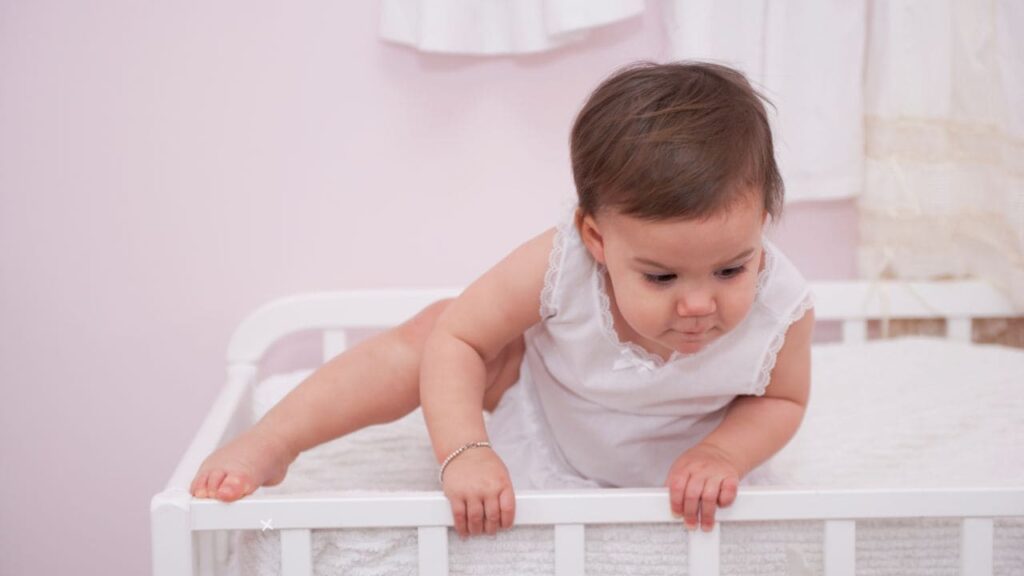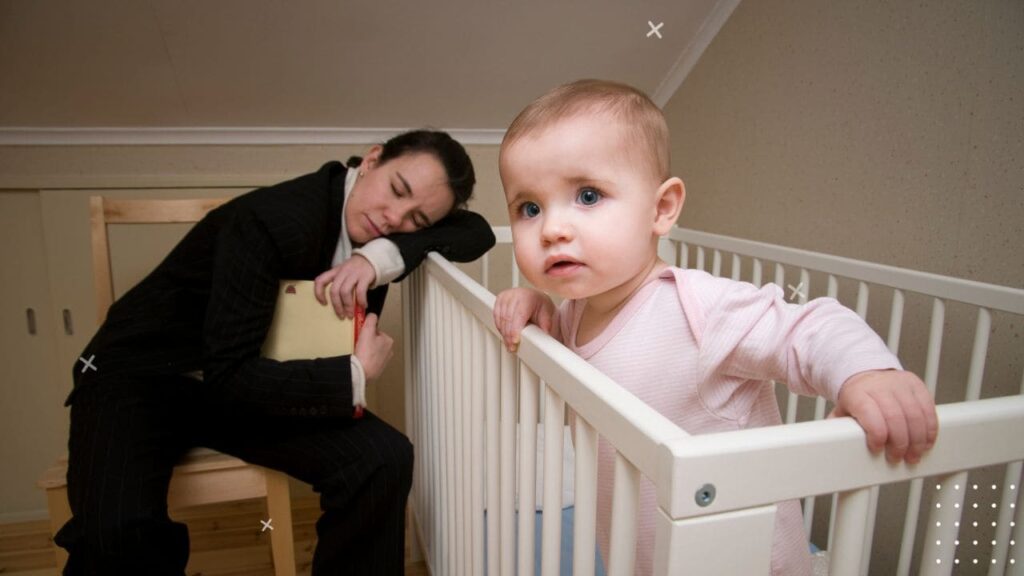As a parent, I know one of the most shocking yet inevitable toddler milestones is the first time you walk into your toddler climbing out of crib and discover they’ve learned how to escape their once-impenetrable baby cage. I still remember finding my son gleefully playing on the floor, the crib bars no match for his newfound climbing skills. My first reaction was definitely panic, immediately worrying about him falling and getting hurt when I wasn’t there to spot him.
However, after taking a deep breath, I realized
is a rite of passage for many toddlers that, while stressful, doesn’t have to be scary. With some preparation and consistent responses, you can help keep your little escape artist safe while transitioning them to a big kid bed. Here are my top 7 tips for navigating this tricky stage without losing too much sleep yourself!
Understanding Why Toddlers Start Climbing
Before diving into solutions, it helps to understand what motivates toddlers to suddenly start scaling their crib walls after months or years of contented sleep. Here are some of the most common reasons the crib gymnastics begin:
- Increasing independence: Around 18 months, toddlers become more mobile, coordinated, and eager to explore their expanding world. Climbing out allows them to take charge.
- Boredom: Toddlers need lots of stimulation, and many treat escapes as a fun challenge or chance to play.
- Changing sleep needs: Dropping naps, early wakes, or frequent night wakings can trigger climbing.
- Major life events: New siblings, illnesses, transitions like potty training can disrupt sleep routines.
The key is not to view climbing as misbehavior. It’s a natural stage. With empathy and consistency from you, it will pass!

Dangers of Crib Climbing
While crib climbing may be developmentally normal, that doesn’t mean it’s 100% safe. When left unattended after escape, tricky toddlers can topple over while climbing or wandering and get injured. They can also access hazards like electronics cords, tipped over lamps, small objects they can choke on, doors and stairs, or toxic chemicals you’d never want within reach.
Even if your toddler seems unphased catapulting themselves over the railing, it’s still an alarming sight for parents to walk in on. And no one wants to wake up to injured cries in the middle of the night!
So while crib climbing isn’t outright dangerous if you take proper precautions, it definitely requires immediate action to keep your roaming toddler safe and help everyone get more sleep.
Baby Proofing The Bedroom
The first step is baby-proofing and toddler-proofing the bedroom to minimize harm if they do free themselves without your knowledge.
- Install padded flooring or thick rugs to cushion falls.
- Secure unstable furniture like dressers to the wall so it can’t tip over if climbed.
- Mount any TVs or shelves firmly to the wall studs.
- Ensure all cords from electronics are neatly bundled and hidden behind furniture.
- Pick up tiny objects that could pose a choking hazard.
- Block access to doors leading to dangerous areas like stairs.
- Cover wall sockets.
- Install safety door knob covers.
I know it’s tempting to think you’ll always hear them climbing out during the day. But spend a few minutes inspecting the bedroom to identify and reduce risks just in case. It gave me peace of mind despite the middle of the night pitter patter of free feet!

Teaching Safe Ways In and Out
Part of the crib climbing motivation is your toddler practicing their independence. They want to choose when to get in and out of bed on their own terms.
Rather than have a power struggle over this, empower them with safe options!
- Show them how to properly climb feet first facing forward. Spot them as needed.
- Demonstrate gently lowering themselves down feet first when getting out, even having stuffed animals “ask” for help.
- Place a soft padded bench or stepped stool near the crib. Encourage climbing down onto it.
- Praise any safe climbing efforts to reinforce it.
- Maybe allow one book per night “read” on the floor before lights out as incentive.
By making independent in and out of bed a collaborative, game-like experience instead of a forbidden act, you remove the thrill of defiance. What seems fun and daring at first becomes routine and mundane for willful toddlers once permitted under supervision.
Role Modeling Desired Sleep Behaviors
As parents, the way we model sleep habits provides an example for our children to follow. Be mindful of your own bedtime routine – follow a predictable sequence of calming activities, speak softly when giving goodnight kisses, and project confidence about the importance of sleep. Avoid letting your toddler see you up watching TV or using electronics right before bed. Lead by example when it comes to healthy sleep!
Adjusting the Mattress Height
If teaching safe climbing doesn’t quite solve the breakouts, try making escape a bit harder first. Lower the mattress to the crib’s lowest level so peering over the top requires more effort. You still want your toddler high enough to see out and feel secure, just with a higher barrier.
If they’re still able to climb out with a lowered mattress no matter how gently you return them, it’s time to reconsider the crib setup.
Using a Sleep Sack Deterrent
Another physical deterrent is a sleep sack worn over pajamas. The sack’s arm openings allow movement but the leg portion is closed for warmth. This restricts their ability to swing a leg over the rails quite so easily. I found sleep sacks most useful for younger toddlers under 2 still transitioning out of that baby mentality.
Some things to consider with sleep sacks:
- Ensure it has a snug but comfortable fit around the torso without impairing breathing.
- Look for sleep sacks with 2-way front zippers for easy overnight diaper changes.
- Use lighter, breathable cotton sacks in warmer months; save fleece for winter.
- Try them for naps first before moving to overnight use if concerned about acceptance.
- Pair with some patience – it may take a week or two for your Houdini to accept their new straitjacket!
Is It Time To Switch From Crib to Bed?
If you’ve tried it all yet still hear the pitter-patter of little feet far too often, your toddler might be unequivocally ready for a big kid bed! Every child reaches this milestone at different ages between 18 months and 3 years old. Here are signals that you may be raring to upgrade:
- They escape the crib most nights consistently despite interventions.
- They seem frustrated with the confined crib space when put down for sleep.
- They appear taller than the crib rails make them seem.
- They ask about or get excited seeing other “big kid beds.”
As bittersweet as this next transition can feel, try viewing it as an exciting step toward your toddler’s maturity rather than babyhood slipping away. And take heart – the crib will still have some good years left for a future sibling!
Big Kid Bed Options
When your climber seems receptively ready, consider these age-appropriate bed alternatives:
Toddler Bed: Essentially a crib with one open side that converts to this intermediate size, usually until age 3-4.
- Familiar feel eases adjustment
- Requires less room than twin bed
- Retains comforting barriers on 3 sides
- Very affordable crib conversion option
Twin/Full Bed: Allows space to stretch out and roll freely. Best for children able to sleep safely without raised barriers.
- Maximizes longevity from age 2 all the way to tween/teen years
- Allows bedsharing with parents more easily when needed
- Provides space for favorite stuffed friends or pillows
Floor Mattress: A fitting montessori-style option for children ready to downgrade from the crib. Easiest to get in and out.
- Achieves big kid bed independence
- Removes injury risk from rolling out of elevated beds
- Fosters decision-making about when to get up
I recommend having a competition to see if your toddler can earn enough stickers by staying in their new bed overnight to get a reward toy. This incentivizes them to adapt quickly and reemphasizes the bed is where they belong for sleeping!

Managing the Transition
Here are my top tips to make the toddler bed transition smoother:
- Involve them picking out new sheets or a stuffie as a reward.
- Set up the bed alongside the crib for a couple weeks to ease acceptance.
- Demonstrate excitement about their “big kid” status often.
- Add a baby gate, soft floor mats or bedrail if it helps reduce worries about falls at first. Consider staying nearby for supervision until the newness wears off.
- Childproof the room further if needed and keep safety top of mind.
- Maintain consistency with pre-bed routines like bath, books, songs.
- Be matter of fact about gently walking them back to bed upon escape; limiting interaction avoids reward.
Expect some initial extra battles at bedtime or wakeups as your toddler revels in their new power to bound freely about the room. But stay consistent returning them to bed calmly, emphasizing this is “sleep time, not play time”. Soon they’ll become conditioned to sleeping soundly through the night in their new upgraded bed!
When To Call The Pediatrician
While phases of epic crib climbing or defiant bedtime antics are developmentally normal, speak to your child’s pediatrician if you have safety concerns or their sleep disruptions become extreme such as:
- Frequent injuries, bruises or complaints of pain from unsupervised bed escapes
- Splitting head open from crib falls
- Signs of dehydration or malnutrition from refusal to sleep
- Dark eye circles, chronic irritability suggesting insufficient sleep
- New onset night terrors or sleepwalking
- Bedwetting associated with newly surfaced sleep issues
Especially if under age 2, such changes warrant discussing whether an underlying issue like illness or ear infection might be provoking the sleep struggles. Toddlers need 11-14 hours of sleep in a 24 hour period, so huge chunks missing can impact behavior and development.
Your pediatrician can also refer you to a sleep specialist or provide customized sleep training advice tailored to your child’s needs. Don’t despair – with some expert guidance and consistency on your part, restful nights will return!
Preserving Daytime Nap Schedules
While navigating crib escapes and big kid beds, maintain your toddler’s usual nap schedule whenever possible. Skipping naps to combat bedtime antics often backfires, resulting in an overtired toddler even more defiant at sleep times. Stick to a daily nap, ideally timed early to mid afternoon. Make naps feel positive and stress-free; avoid harsh wakeups. Protecting daytime sleep helps reinforce good habits for when bedtime rolls around and facilitates longer overnight sleep stretches.
| Sleep Disruptor | Potential Solutions |
|---|---|
| New sibling | Maintain nap schedule/bedtime routine, acknowledge emotions |
| Illness | Extra comforting, fluid intake; call doctor if extreme |
| Potty training | Protect naps/bedtime, nighttime diaper if needed |
| Sleep regression | Consistency with schedule, added comfort item |
| Teething pain | Teething toys/meds before bed |
| Childhood fears | Calming bedtime routine, comfort item, night light |
Additional Resources
For parents struggling with persistent toddler sleep issues, additional help is available. Consult your pediatrician for referrals to sleep medicine specialists at children’s hospitals who can advise on toddler sleep training methods. Consider hiring a sleep consultant to create a personalized sleep plan tailored your child’s habits. Check community resources like parenting classes at daycares, recreation centers and churches around toddler sleep challenges. And know there is a whole tribe of parents facing the same crib escapades and dramatic bedtime antics right along with you! With some creativity and added support, this too shall sleep.
| Sleep Training Method | How it Works | Duration |
|---|---|---|
| Graduated Extinction | Increasing wait times before responding to protests from 5 mins up to 15+ mins | 3-14 nights |
| Bedtime Fading | Gradually delaying bedtime by 15 mins each night to match natural sleepiness | 7-10 nights |
| Scheduled Awakenings | Parent-led night wakings on schedule to preempt self-wakings; intervals widened over time | 1-2 weeks |
| Positive Routines | Reinforcing desired bedtime behaviors with rewards; not leaving until asleep | 2-4 weeks |
The Key is Consistency and Patience!
In conclusion – while witnessing escapes induces panic, stay patient and positive! Trust that even the wiliest of toddlers cannot outlast a consistent bedtime routine reinforced by calm limit-setting. Commit to your sleep training game plan, ask for help if needed, and soon your toddler will be sleeping soundly once more!
Sweet dreams!
FAQ – Toddler Climbing Out of Crib?
Why has my 18 month old suddenly started trying to climb out of their crib? They’ve never tried this before.
Several factors often motivate toddlers around 18 months old to begin scaling their crib walls when they never have previously. Their mobility and coordination increases substantially by this age so they have the capability for the first time. Crib climbing also aligns with their drive for independence and desire to have more control. Major developmental leaps, sleep need changes, boredom, or life disruptions can all trigger the newfound interest too. Know that this behavior is very developmentally appropriate even if shocking!
My toddler just switched to a big kid bed but won’t stay in it. They play for hours if I don’t sit in the room. Help!
Congratulations on this big transition! It’s completely normal for newly minted “big kids” to test limits with their new bed freedom. Try designating some special new toys or books they can only access in their bed to provide incentive. Maintain your calm bedtime routine then matter-of-factly walk them back to bed every time they get up. Stay confident and consistent – this too shall pass! It just takes time for the novelty to fade. perhaps use a baby gate to keep them safely contained in their room. You’ve got this!
I’m hesitant to take away the crib since my toddler still tries climbing out but has gotten injured falling a few times. Any better options?
It’s so hard seeing them get hurt from escaping! You can try dropping the mattress to the lowest level so peering over the top requires more effort before fully transitioning. Just ensure they can still see out for comfort. A sleep sack worn over pajamas also restricts their mobility which deters climbing. Supervise any crib climbing attempts and teach feet-first technique. And truly childproof the room to cushion any falls. Meet with your pediatrician if injuries persist or you need additional advice on handling this tricky situation.
How do I get my toddler to sleep all night in their new big kid bed?
Achieving all-night sleep in a new environment takes time but consistency is key! Maintain your positive bedtime routine. Use toddler-proof knob covers and baby gates as needed to keep them safely contained. Respond minimally when they call out, then walk them calmly back to bed every time with little fanfare. Offer a special stuffed buddy or blanket for comfort. Consider an incentive system like rewards tickets they can “spend” for prizes in the morning for each night slept through. This too shall sleep!
Could recurring toddler sleep disruptions signify an underlying issue?
While phases of climbing, defiant bedtime antics and night wakings are often normal, extreme or prolonged behavior changes warrant a closer look, especially under age 2. Consult your pediatrician if you notice signs like chronic exhaustion, irritability or dehydration, injuries/complaints of pain from unsupervised bed escapes, split head open from crib falls new sleep issues like bedwetting, night terrors or walking. An illness, ear infection, upcoming developmental leap or discomfort like teething could be provoking struggles. Your ped can check for issues and provide referrals to sleep specialists if needed. Don’t lose hope, solutions are available!












